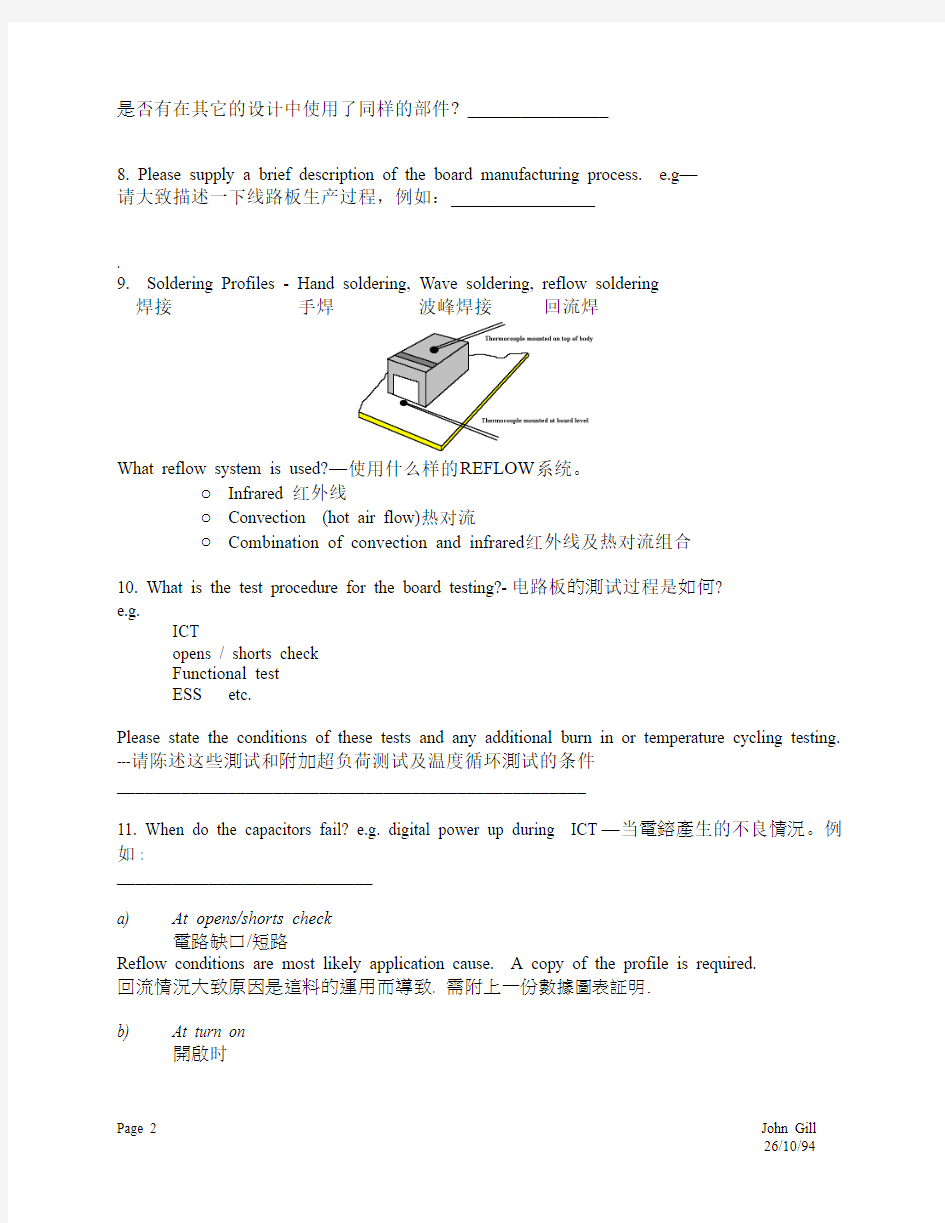TACHECKLIST_to_customer


A KYOCERA GROUP COMPANY
Failure Investigation Data Checklist
___________________________________________________________
Date:
Customer: Rep:
Contact:
Phone:
FAX:
___________________________________________________________
1. What is the part type and capacitance / voltage giving cause for concern?/D/C or INV NO e.g. 料號的型号是什么?. ____ _______
D/C: _______________________________
INV NO: _______________________________
2. How do the parts fail? Open circuit, short circuit, parametric (Cap, DF, ESR, DCL)—
如何產生不良?電路缺口,短路,参数
_____________________________________
3. How long has the present design and revision level of the board been under construction?
已產生多長時間在目前的设计版本的電路板中?
_________________________________
4. When did failures start to occur?Failures %?
什么時候产生不良?不良率多少?
________________
5. Are other vendors parts used in the same application?
是否有其它供应商的产品在同一情况下使用? ________________
Are other vendor parts also failing?
其它供應商的产品是否也产生了不良? ________________
6. Have there been any recent modifications to board or process?
最近是否有對电路板進行修改或是处理? ________________
7. Are the same components used in other designs?
是否有在其它的设计中使用了同样的部件? ________________
8. Please supply a brief description of the board manufacturing process. e.g—
请大致描述一下线路板生产过程,例如:________________
.
9. Soldering Profiles - Hand soldering, Wave soldering, reflow soldering
焊接手焊波峰焊接回流焊
What reflow system is used?—使用什么样的REFLOW系统。
o Infrared 红外线
o Convection (hot air flow)热对流
o Combination of convection and infrared红外线及热对流组合
10. What is the test procedure for the board testing?-电路板的測试过程是如何?
e.g.
ICT
opens / shorts check
Functional test
ESS etc.
Please state the conditions of these tests and any additional burn in or temperature cycling testing. ---请陈述这些測试和附加超负荷测试及温度循环測试的条件
___________________________________________________
11. When do the capacitors fail? e.g. digital power up during ICT—当電鎔產生的不良情況。例如 :
____________________________
a) At opens/shorts check
電路缺口/短路
Reflow conditions are most likely application cause. A copy of the profile is required.
回流情況大致原因是這料的運用而導致. 需附上一份數據圖表証明.
b) At turn on
開啟时
A copy of the voltage / current profile measured across / through the capacitor at the test known to cause the failure mode is ideal when trying to determine if there is an application issue.
提供一份有關通過電鎔測試的電壓/目前數據圖表以確認這不良方式是因這料而產生.
The current is best measured using a current probe as shown in the following diagram.
c) After burn in or environmental
燒毀
What are the temperatures, dwells and ramp rates of temperature, and when are the capacitors powered.
有關的溫度, 詳情和溫度活動率, 及當這料啟用的時間.
d) Random
無規則的
i) Please supply a copy of circuit diagram.-请提供线路图
ii) Are the failures specific to a few board locations? If so, what is the failure rate by board location?
不良是否只先特别產生在某些电路板中?如果是这样,那不良的比率是多少?
__________________________________________
iv) What is the maximum DC voltage the capacitor is likely to be subjected to? Please quote the typical value with the range, e.g. 9 volts ± 0.5 volts or 6 to 12 volts.
这个电鎔给的最大的直流电压是什么,请给出一个范围值,如:9V±0.5 volts 或是 6V-12V _____________________ V
v) If the capacitor is connected to a switching inductive load, please provide details of the switching frequency, inductance value and any flyback diodes used.
如這電鎔是連接開關感應, 請提供詳細的開關的頻率,電感數值, 及其他回流的兩極真空管
_________________________________________________
vi) Is it possible for the tantalum to see negative voltages?
電鎔是否有產生負電壓?
vii) If the parts are hand inserted, how is the part ensured to be correctly oriented in the circuit? 如果這電鎔是人手按裝, 如何確定是否正確安裝在線路上?
_______________
